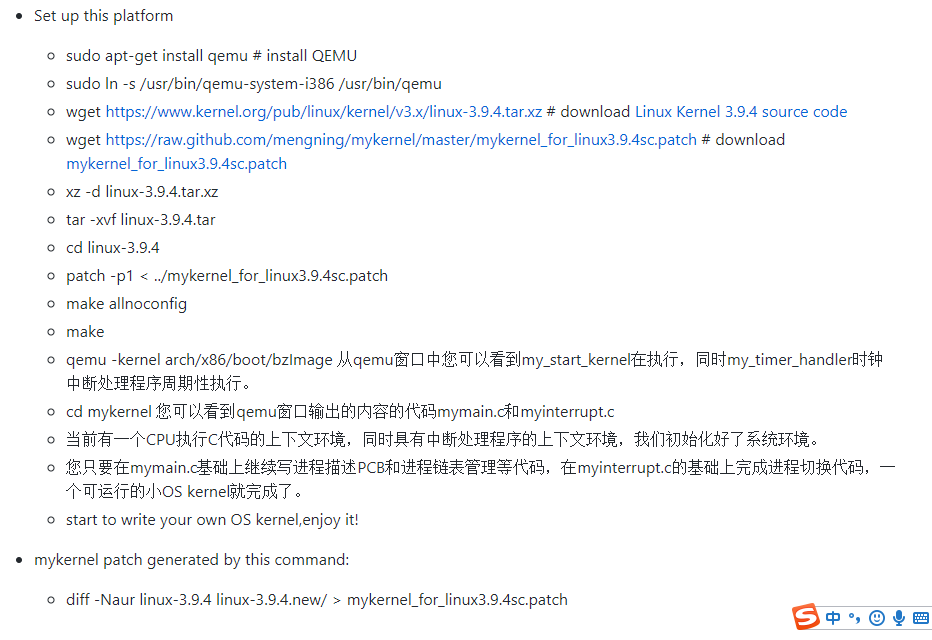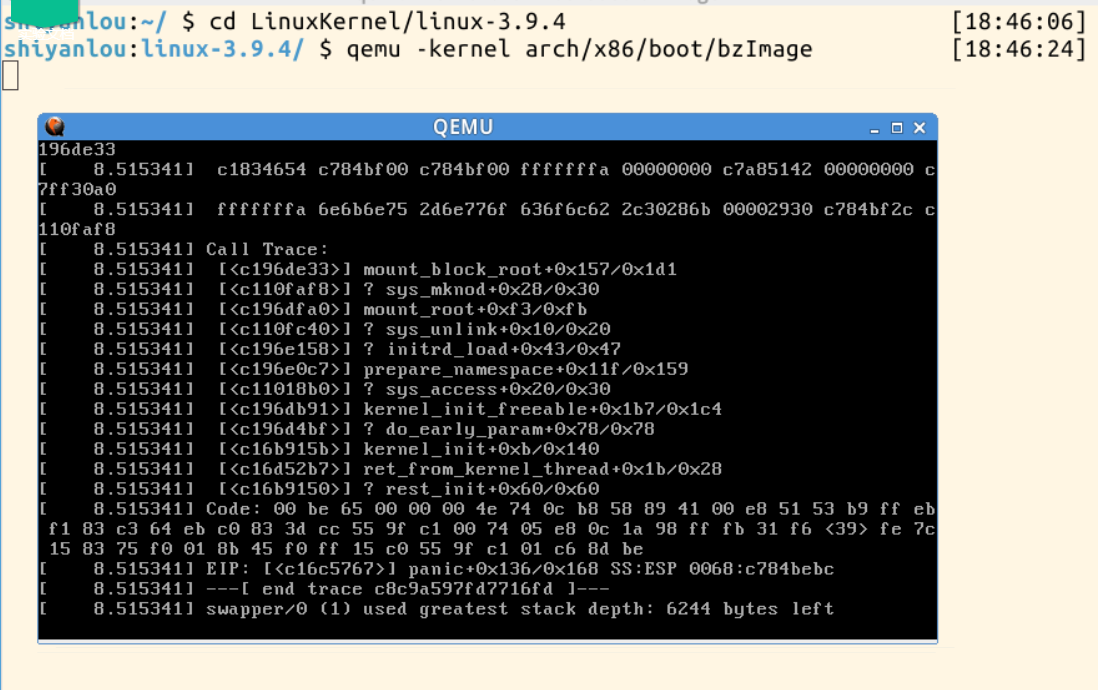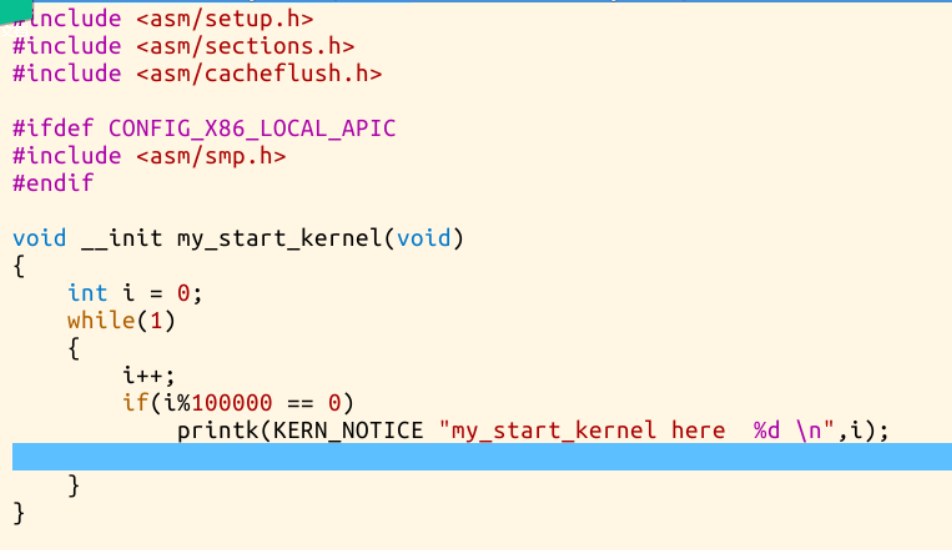实验一:基于mykernel的一个简单的时间片轮转多道程序内核代码分析
实验一:基于mykernel的一个简单的时间片轮转多道程序内核代码分析
学号293,转载请注明出处
本实验来源: https://github.com/mengning/linuxkernel/
一、mykernel
这是孟老师基于linux kernel 3.9.4 source code建立的开发操作系统内核平台。
可以根据老师写的readme文件进行部署

也可以直接在实验楼课程中提供的实验环境进行实验
二 、实验分析
本实验采取在实验楼提供的环境中进行实验
首先可以通过以下命令,查看QEMU虚拟机
cd LinuxKernel/linux-3.9.4
qemu -kernel arch/x86/boot/bzImage
结果如下:

cd mykernel

可以看到在mymain.c中的 my_start_kernel函数中:

即为一个循环,不停的输出my_start_kernel here.
然后查看myinterrupt.c

类似也是一个my_timer_handler函数
输出
"\n>>>>>>>>>>>>>>>>>my_timer_handler here<<<<<<<<<<<<<<<<<<\n\n"
以上也就是我们看到的运行的qemu得到的结果,不停地输出这两个字符串。
三、实现一个简单的时间片轮转多道程序
可以使用mykernel中提供的示例代码,这里我们通过git来下载源代码文件


此时已经将clone下来的我们需要的文件移动到了Linkernel/linux3.9.4/mykernel中了
然后需要重新编译下工程。
make allnoconfig
make -j4
qemu -kernel arch/x86/boot/bzImage
结果如下:

四、源代码分析
主要是三个文件mypcb.h mymain.c myinterrupt.c
在mypcb.h中主要是进程控制块PCB的结构体定义
/*
* linux/mykernel/mypcb.h
*
* Kernel internal PCB types
*
* Copyright (C) 2013 Mengning
*
*/
#define MAX_TASK_NUM 4
#define KERNEL_STACK_SIZE 1024*2 //unsigned long (这个地方源代码有错误不能用#注释)
/* CPU-specific state of this task */
struct Thread {
unsigned long ip;
unsigned long sp;
};
typedef struct PCB{
int pid;
volatile long state; /* -1 unrunnable, 0 runnable, >0 stopped */
unsigned long stack[KERNEL_STACK_SIZE];
/* CPU-specific state of this task */
struct Thread thread;
unsigned long task_entry;
struct PCB *next;
}tPCB;
void my_schedule(void);
Thread结构体,用于存储当前线程的ip,sp
pid是进程号,state 进程状态,stack进程使用的栈, thread当前的线程信息,task_entry进程入口函数,next:指向下一PCB(假设进程是以链表的形式连接起来的)
这里也声明了my_schedule函数,实现在my_interrupt.c,在main.c中的各个进程函数会根据一个全局变量的状态来决定是否调用它,从而实现主动调度。
在mymain.c中,初始化各个进程并启动0号进程
/*
* linux/mykernel/mymain.c
*
* Kernel internal my_start_kernel
*
* Copyright (C) 2013 Mengning
*
*/
#include <linux/types.h>
#include <linux/string.h>
#include <linux/ctype.h>
#include <linux/tty.h>
#include <linux/vmalloc.h>
#include "mypcb.h"
tPCB task[MAX_TASK_NUM];
tPCB * my_current_task = NULL;
volatile int my_need_sched = 0;
void my_process(void);
void __init my_start_kernel(void)
{
int pid = 0;
int i;
/* Initialize process 0*/
task[pid].pid = pid;
task[pid].state = 0;/* -1 unrunnable, 0 runnable, >0 stopped */
task[pid].task_entry = task[pid].thread.ip = (unsigned long)my_process;
task[pid].thread.sp = (unsigned long)&task[pid].stack[KERNEL_STACK_SIZE-1];
task[pid].next = &task[pid];
/*fork more process */
for(i=1;i<MAX_TASK_NUM;i++)
{
memcpy(&task[i],&task[0],sizeof(tPCB));
task[i].pid = i;
task[i].state = -1;
task[i].thread.sp = (unsigned long)&task[i].stack[KERNEL_STACK_SIZE-1];
task[i].next = task[i-1].next;
task[i-1].next = &task[i];
}
/* start process 0 by task[0] */
pid = 0;
my_current_task = &task[pid];
asm volatile(
"movl %1,%%esp\n\t" /* set task[pid].thread.sp to esp */
"pushl %1\n\t" /* push ebp */
"pushl %0\n\t" /* push task[pid].thread.ip */
"ret\n\t" /* pop task[pid].thread.ip to eip */
"popl %%ebp\n\t"
:
: "c" (task[pid].thread.ip),"d" (task[pid].thread.sp) /* input c or d mean %ecx/%edx*/
);
}
void my_process(void)
{
int i = 0;
while(1)
{
i++;
if(i%10000000 == 0)
{
printk(KERN_NOTICE "this is process %d -\n",my_current_task->pid);
if(my_need_sched == 1)
{
my_need_sched = 0;
my_schedule();
}
printk(KERN_NOTICE "this is process %d +\n",my_current_task->pid);
}
}
}
正如前文所述,这里的函数 my_start_kernel 是系统启动后,最先调用的函数,在这个函数里完成了0号进程的初始化和启动,并创建了其它的进程PCB,以方便后面的调度。在模拟系统里,每个进程的函数代码都是一样的,即 my_process 函数,my_process 在执行的时候,会打印出当前进程的 id,从而使得我们能够看到当前哪个进程正在执行。
另外,在 my_process 也会检查一个全局标志变量 my_need_sched,一旦发现其值为 1 ,就调用 my_schedule 完成进程的调度。
0号线程的启动,采用了内联汇编代码完成,详细参见源码中的注释。
在myinterrupt.c:时钟中断和进程调度的算法
/*
* linux/mykernel/myinterrupt.c
*
* Kernel internal my_timer_handler
*
* Copyright (C) 2013 Mengning
*
*/
#include <linux/types.h>
#include <linux/string.h>
#include <linux/ctype.h>
#include <linux/tty.h>
#include <linux/vmalloc.h>
#include "mypcb.h"
extern tPCB task[MAX_TASK_NUM];
extern tPCB * my_current_task;
extern volatile int my_need_sched;
volatile int time_count = 0;
/*
* Called by timer interrupt.
* it runs in the name of current running process,
* so it use kernel stack of current running process
*/
void my_timer_handler(void)
{
#if 1
if(time_count%1000 == 0 && my_need_sched != 1)
{
printk(KERN_NOTICE ">>>my_timer_handler here<<<\n");
my_need_sched = 1;
}
time_count ++ ;
#endif
return;
}
void my_schedule(void)
{
tPCB * next;
tPCB * prev;
if(my_current_task == NULL
|| my_current_task->next == NULL)
{
return;
}
printk(KERN_NOTICE ">>>my_schedule<<<\n");
/* schedule */
next = my_current_task->next;
prev = my_current_task;
if(next->state == 0)/* -1 unrunnable, 0 runnable, >0 stopped */
{
/* switch to next process */
asm volatile(
"pushl %%ebp\n\t" /* save ebp */
"movl %%esp,%0\n\t" /* save esp */
"movl %2,%%esp\n\t" /* restore esp */
"movl $1f,%1\n\t" /* save eip */
"pushl %3\n\t"
"ret\n\t" /* restore eip */
"1:\t" /* next process start here */
"popl %%ebp\n\t"
: "=m" (prev->thread.sp),"=m" (prev->thread.ip)
: "m" (next->thread.sp),"m" (next->thread.ip)
);
my_current_task = next;
printk(KERN_NOTICE ">>>switch %d to %d<<<\n",prev->pid,next->pid);
}
else
{
next->state = 0;
my_current_task = next;
printk(KERN_NOTICE ">>>switch %d to %d<<<\n",prev->pid,next->pid);
/* switch to new process */
asm volatile(
"pushl %%ebp\n\t" /* save ebp */
"movl %%esp,%0\n\t" /* save esp */
"movl %2,%%esp\n\t" /* restore esp */
"movl %2,%%ebp\n\t" /* restore ebp */
"movl $1f,%1\n\t" /* save eip */
"pushl %3\n\t"
"ret\n\t" /* restore eip */
: "=m" (prev->thread.sp),"=m" (prev->thread.ip)
: "m" (next->thread.sp),"m" (next->thread.ip)
);
}
return;
}
这里 my_timer_handler 函数会被内核周期性的调用,每调用1000次,就去将全局变量my_need_sched的值修改为1,通知正在执行的进程执行调度程序my_schedule。在my_schedule函数中,完成进程的切换。进程的切换分两种情况,一种情况是下一个进程没有被调度过,另外一种情况是下一个进程被调度过,可以通过下一个进程的state知道其状态。进程切换依然是通过内联汇编代码实现,无非是保存旧进程的eip和堆栈,将新进程的eip和堆栈的值存入对应的寄存器中,详见代码中的注释。
五、总结
在本次的学习和实验中,了解了操作系统中的进程的调度机制与其中断机制,了解一下C语言内嵌汇编的方法。
操作系统通过其对硬件的控制,合理分配计算机资源,实现多任务处理,使用户更加容易的操作计算机。




 浙公网安备 33010602011771号
浙公网安备 33010602011771号